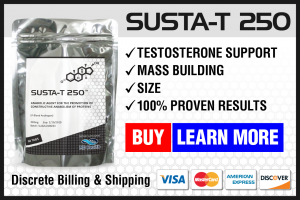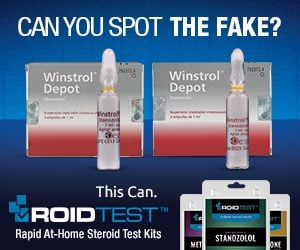Even though Testosterone might exhibit certain side effects that other anabolic steroid analogues have effectively eliminated (such as aromatization into Estrogen, for example), Testosterone indeed remains the safest anabolic steroid that any individual can elect to use. This is because Testosterone is quite literally the original anabolic steroid that is endogenously and naturally manufactured by humans and nearly all animal life. It is therefore a safe choice, especially for beginners and brand new first-time users, to utilize any form of Testosterone as their primary choice in their first cycle. Because it is already naturally manufactured by humans, the body is well accustomed to the effects of Testosterone on its cells and systems, and there has been plenty of clinical research conducted upon Testosterone and its effects on the body that nearly all of the knowledge of Testosterone Suspension side effects that could possibly occur are well-documented and well-known. This information is easily accessible to most, especially in today’s day and age of the internet. It is a fact that there exists more clinical and medical data (and general information) on Testosterone and the different esterified variants than any other anabolic steroid in existence.
Testosterone is not without its potential side effects, however, but it is through the almost complete understanding of Testosterone Suspension side effects that allows us to properly understand and therefore prevent or deal with them appropriately.
Estrogenic Side Effects
Testosterone Suspension side effects indeed do carry with it an element of Estrogen related side effects. Testosterone is classified as being moderately aromatizable, and is readily converted into Estrogen in the body. This is accomplished by the aromatase enzyme, which locates Testosterone as the target substrate and proceeds to engage in a chemical reaction that converts (aromatizes) it into Estrogen. Testosterone Suspension side effects as they relate to Estrogen might possibly be worse in some individuals than other forms of Testosterone, simply due to its very fast acting nature. However, estrogenic side effects are known to occur in relation to the dose of Testosterone (or any aromatizable anabolic steroid) used. The greater the dose of Testosterone Suspension, the greater the probability and amount of aromatisation that will occur, leading to an increased incidence of Estrogen-related side effects. The use of Testosterone Suspension at bodybuilding (supraphysiological) doses will usually result in greater amounts of Estrogen buildup, which must be dealt with in some way.
The option to use a SERM (Selective Estrogen Receptor Modulator) such as Nolvadex (Tamoxifen) is a popular choice, though SERMs will only act to block the activity of Estrogen in certain tissues (namely in breast tissue). SERMs will therefore only block certain side effects, such as gynecomasta (the development of breast tissue), but they will not reduce total circulating Estrogen levels in the body. In order to accomplish this, the use of an aromatase inhibitor (AI) is required. Aromatase inhibitors, such as Aromasin (Exemestane), Arimidex (Anastrozole), or Letrozole (Femara) work to bind to the aromatase enzyme and inhibit its ability to interact with Testosterone. Therefore, the origin of the production of Estrogen in the body is effectively halted, which reduces total circulating levels of Estrogen. This can effectively reduce or eliminate Estrogen related side effects such as bloating, water retention, gynecomastia, and more. SERMs will only serve to block or prevent gynecomastia, but will do nothing for bloating or water retention.
Estrogenic side effects include the following: water retention and bloating, blood pressure elevations (as a result of the water retention), increased possible fat retention/gain, and gynecomastia.
Androgenic Side Effects
Because Testosterone is the number one primary male androgen, Testosterone Suspension side effects do carry with it the potential for androgenic side effects to occur. Bodybuilding doses of Testosterone will increase the likelihood of androgenic side effects to occur. Furthermore, it is known that the overwhelming majority of androgenic side effects that occur with Testosterone are actually the result of Dihydrotestosterone (DHT), which is a metabolite of Testosterone. As Testosterone passes through certain tissues (such as the scalp, skin, and prostate), an enzyme that is highly abundant within these tissues known as 5-alpha reductase (5AR) will convert (or reduce) Testosterone into Dihydrotestosterone. Dihydrotestosterone is a much more potent androgen (approximately 5 times more potent) than Testosterone, and it is DHT that is primarily responsible for many androgenic side effects as a result of Testosterone use, such as male pattern baldness, acne, oily skin, etc.
These potential Testosterone Suspension side effects can be effectively reduced or controlled a greater deal through the use of 5-alpha reductase inhibitors, such as Proscar, Propecia, or Finasteride. These drugs will inhibit the 5AR enzyme in much the same way as aromatase inhibitors will inhibit the aromatase enzyme. The end result is a drastic reduction in DHT levels, as DHT cannot be produced. It is important for every individual to understand, however, that the androgenic side effects of Testosterone Suspension will not be completely eliminated through the use of a 5AR inhibitor, as Testosterone itself exhibits a measure of androgenicity in the body, and can still cause androgenic side effects to occur even without the ability to be converted into DHT. In such cases, some individuals can elect to use a topical DHT blocker, such as Nizoral, on areas troubled by androgens (such as the scalp and areas of the body that are prone to bad acne breakouts during anabolic steroid use). Nizoral shampoo’s active ingredient Ketoconazole acts as a topical DHT blocker in skin and scalp, effectively reducing the probability of androgens triggering male pattern baldness as well as acne breakouts caused by increased oily skin.
Androgenic side effects include: increased sebum secretion (oily skin), increased bouts of acne (linked to increased sebum secretion), bodily and facial hair growth, benign prostatic hypertrophy (BPH), and the increased risk of triggering Male Pattern Baldness (MPB) in individuals that possess the genetic trait required for the condition to manifest itself.
HPTA and Endogenous Testosterone Production Side Effects
All anabolic steroids, Testosterone Suspension included, when administered at supraphysiological bodybuilding doses will cause the body to either suppress or completely shut down its own natural endogenous manufacture of Testosterone. This is also known as HPTA (Hypothalamic Pituitary Testicular Axis) suppression/shutdown. Testosterone Suspension side effects are no exception to this rule for all anabolic steroids. After the conclusion of a cycle, a proper PCT (Post Cycle Therapy) program should be initiated by the user, typically lasting 4 – 6 weeks after the conclusion of a cycle. PCT includes the use of compounds that stimulate Testosterone production in the body and allow the HPTA to resume its normal function again. If an anabolic steroid user fails to engage in a proper PCT, the chances of developing permanent hypogonadism (the insufficient production of Testosterone) become quite high, in which case the individual might have to seek medical therapy in the form of TRT (Testosterone Replacement Therapy) for the remainder of his life.
Hepatotoxic Side Effects
Because Testosterone is not C17-alpha alkylated (C17AA), which is the modification necessary to make an anabolic steroid hormone orally active, it expresses no negative effects on the liver. Liver toxicity in clinical studies as a result of Testosterone use has been found to be nonexistent. In one particular study, Testosterone was administered at very high doses (400mg daily, which equates to 2,800mg weekly) in several male test subjects for a 20 day period where the route of administration was actually oral instead of intramuscular injections. The idea in administering it orally rather than the traditional intramuscular injection is to saturate the liver with high amounts of Testosterone (all orally ingested substances a ‘first pass’ through the liver and interact with the liver at a far greater degree than the injectable routes of administration). The result of the study indicated no changes in liver enzyme values in the test subjects[1]. Because Testosterone Suspension is to be administered via injection anyhow, there is even less of a chance of any hepatotoxicity to occur even if it was discovered that Testosterone did affect the liver in such a manner. Therefore, hepatotoxicity is not of any concern where Testosterone Suspension side effects are concerned.
Cardiovascular Side Effects
Negative cardiovascular side effects (especially as a result of negative impacts on cholesterol values) are all general side effects of all anabolic steroids, and Testosterone Suspension side effects are no exception to this. Oral anabolic steroids tend to be the worst offenders for cardiovascular risk through their excessively negative impact on cholesterol values, far more than injectable compounds.
The negative cholesterol alterations involves the reduction of HDL (the good cholesterol) and increases of LDL (the bad cholesterol). The result of such changes involves an increased risk of arteriosclerosis, and the degree to which these changes occur for the worse are usually dose-dependent (with higher doses increasing the negative changes and the risks). Other factors that affect these negative cholesterol changes are: duration of use, and route of administration. Testosterone itself actually happens to exhibit far less of an impact on cholesterol values in this case than all other anabolic steroids, as one of the contributing factors in this case is due to the liver’s ability to freely and easily metabolize Testosterone in comparison with other anabolic steroids, and the fact that Testosterone is not very resistant to hepatic breakdown and metabolism. The issue where hepatotoxicity is concerned mostly stems from certain anabolic steroids that possess the trait of exhibiting heavier resistance to hepatic metabolism than Testosterone does. This is perhaps the number one primary culprit as to why oral anabolic steroids express greater amounts of hepatotoxicity – the C17-alpha alkylation causes the anabolic steroid to become further resistant to being metabolized or broken down by the liver. The concern as to whether an anabolic steroid has a high resistance to hepatic metabolism or a low resistance is a factor in how much impact a given anabolic steroid has on the liver’s regulation of cholesterol levels and production.
Testosterone in particular has demonstrated in one clinical study to have only a mild negative impact on HDL cholesterol after a 12 week period, where 280mg of Testosterone Enanthate was administered weekly. The cholesterol profiles had later changed for the worse when an aromatase inhibitor was included, which resulted in a significant 25% drop in HDL cholesterol[2]. Conversely, other studies have been conducted whereby 300mg weekly of Testosterone Enanthate was administered for a 20 week period without the use of an aromatase inhibitor which resulted in a 13% reduction of HDL cholesterol, however, when Testosterone doses were raised to 600mg weekly, reduction of HDL cholesterol had dropped to 21%[3]. These studies provide a perfect example that the increase in Estrogen through aromatization and liver metabolism is actually beneficial, as this increase in Estrogen offsets the negative cholesterol changes as a result of bodybuilding doses of Testosterone or other anabolic steroids. This makes sense, considering Estrogen itself is known to promote positive changes on cholesterol levels. Therefore, the use of an aromatase inhibitor and its impact on cholesterol values should always be kept in mind during the use of aromatase inhibitors while on a cycle.
It is therefore a better idea to instead utilize minimal aromatase inhibitor doses during anabolic steroid cycles only for the purpose of Estrogen control, rather than total Estrogen level elimination. The idea here is to maintain Estrogen levels at normal (or as close as possible to normal) physiological ranges and not allow them to skyrocket as a result of aromatization, whilst at the same time prevent Estrogen levels from plummeting to near zero as a result of full or excessive doses of an aromatase inhibitor.
Testosterone Suspension References:
[1] Enzyme induction by oral testosterone. Johnsen SG, Kampmann JP, Bennet EP, Jorgensen F. 1976 Clin Pharmacol Ther 20:233-237
[2] High-density lipoprotein cholesterol is not decreased if an aromatizable androgen is administered. Friedl K, Hannan C et al. Metabolism 39(1) 1990;
[3] Testosterone dose-response relationships in healthy young men. Bhasin S, Woodhouse L. et al. Am J Physiol Endocrinol Metab 281:E1172-81, 2001






